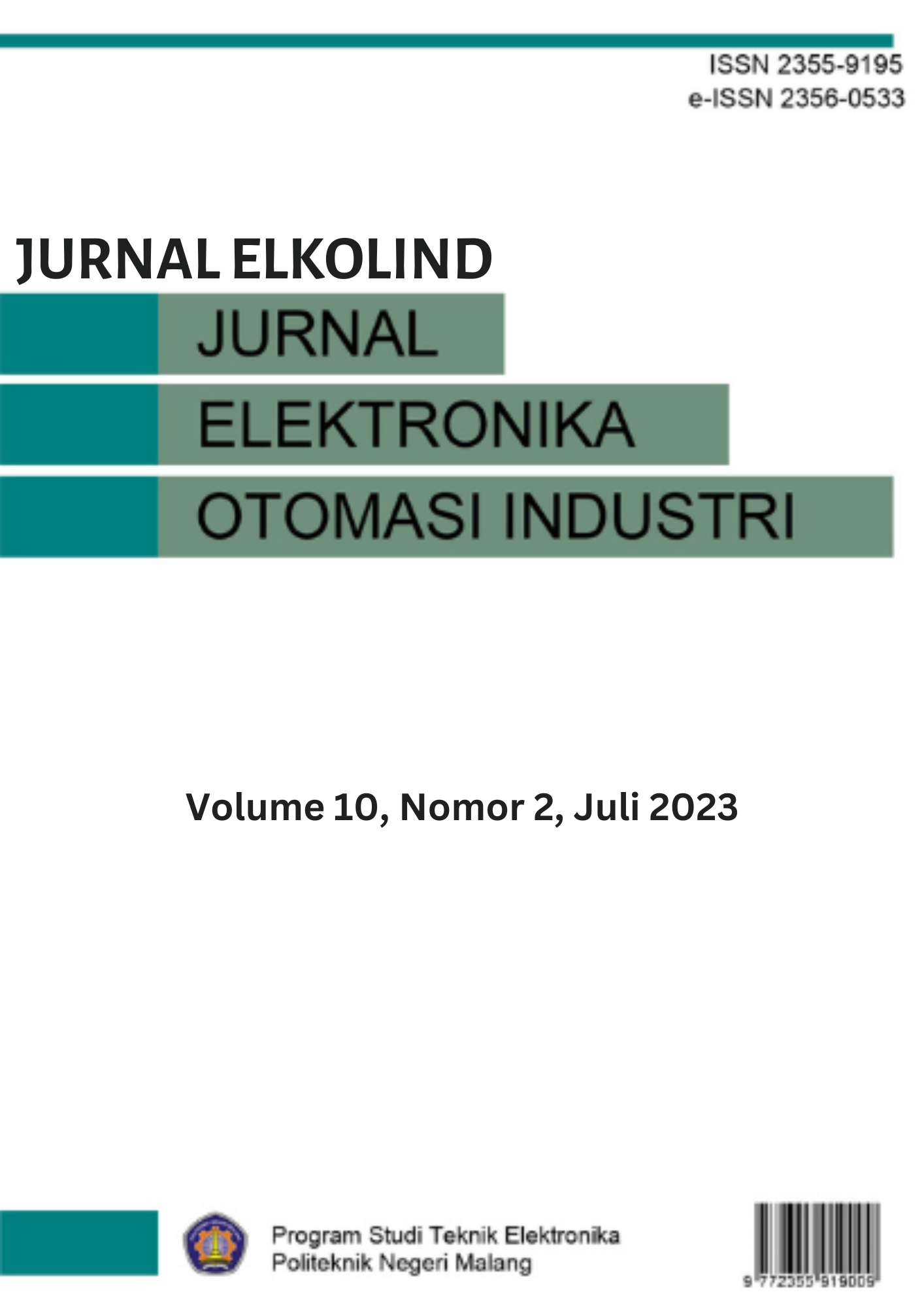Main Article Content
Abstract
Grafik karakteristik transistor menunjukkan hubungan antara arus basis kolektor dan tegangan emitter kolektor. Informasi tersebut dimanfaatkan untuk menentukan penguatan transistor, titik saturasi, dan titik cutoff. Pengukuran manual di laboratorium untuk mendapatkan grafik karakteristik transistor membutuhkan waktu yang lama karena analis diharuskan mengendalikan banyak instrumen pada saat yang sama. Akibatnya, alat khusus diperlukan untuk secara otomatis mengukur grafik dengan pengaturan tes yang dapat diubah dan memvisualisasikan hasil tes. Dalam studi ini, mereka membahas bagaimana membangun pelacak kurva menggunakan Source Measure Unit (SMU) dan mikrokontroler arsitektur ARM untuk mengontrol output dan menangkap data dengan cepat. Interface pelacak kurva dikembangkan pada komputer menggunakan aplikasi LabVIEW untuk menentukan pengaturan tes dan menyajikan visualisasi grafis dari hasil tes. Ketepatan output tegangan dari SMU adalah 0.01% dan ketepatannya output saat ini adalah 0.35%. Akurasi karakteristik transistor pada pelacak kurva dibandingkan dengan osiloskop adalah 2.48%.
Keywords
Article Details
Copyright (c) 2023 sungkono, leonardo kamajaya, fitri, Arief Rahman Hidayat, Achmad Arif Bryantono

This work is licensed under a Creative Commons Attribution 4.0 International License.
References
- E. Moreno-Garcia, “Curve tracer with a personal computer and LabView,” in 14th International Conference on Electronics, Communications and Computers, 2004. CONIELECOMP 2004., 2004, pp. 202–207.
- G. T. Nikolov, “High current source-measure unit based on low cost DAQ,” Proc. Electron., 2008.
- A. Seyhoonzadeh, H. Chang, and K. E. Lonngren, “Inexpensive transistor curve tracer,” Rev. Sci. Instrum., vol. 58, no. 5, pp. 849–852, 1987.
- J. M. Patterson, “Developing an approach to semiconductor failure analysis and curve tracer interpretation,” in 16th International Reliability Physics Symposium, 1978, pp. 93–100.
- E. J. Hill, “A Simple Transistor Characteristic Curve Tracer,” in Proceedings of the Iowa Academy of Science, 1962, vol. 69, no. 1, pp. 455–458.
- A. Das, “An easy-to-fabricate source measure unit for real-time DC and time-varying characterization of multi-terminal semiconductor devices,” Eng. Res. Express, vol. 3, no. 1, p. 15003, 2021.
- R. Ortega, “New source measure unit architecture for control loop configurability,” in 2012 IEEE AUTOTESTCON Proceedings, 2012, pp. 157–160.
- P. Horowitz and W. Hill, “The Art of Electronics. Third.” Cambridge University Press, 2015.
- M. J. Deen and F. Pascal, “Electrical characterization of semiconductor materials and devices,” J. Mater. Sci. Mater. Electron., vol. 17, no. 8, pp. 549–575, 2006.
- A. I. Khan, A. Keshavarzi, and S. Datta, “The future of ferroelectric field-effect transistor technology,” Nat. Electron., vol. 3, no. 10, pp. 588–597, 2020.
- P. Chuang et al., “All-electric all-semiconductor spin field-effect transistors,” Nat. Nanotechnol., vol. 10, no. 1, pp. 35–39, 2015.
- S. Saurabh and M. J. Kumar, Fundamentals of tunnel field-effect transistors. CRC press, 2016.
- D. Tekleab, “Device performance of silicon nanotube field effect transistor,” IEEE electron device Lett., vol. 35, no. 5, pp. 506–508, 2014.
- L. Guili and K. Quancun, “Design of virtual oscilloscope based on GPIB interface and SCPI,” in 2013 IEEE 11th International Conference on Electronic Measurement & Instruments, 2013, vol. 1, pp. 294–298.
- T. Instruments, “High-voltage, high-current operational amplifier.” 2005.
- T. Instruments, “Ina226 high-side or low-side measurement, bi-directional current and power monitor with i2c compatible interface,” INA226, pp. 1–39, 2015.
References
E. Moreno-Garcia, “Curve tracer with a personal computer and LabView,” in 14th International Conference on Electronics, Communications and Computers, 2004. CONIELECOMP 2004., 2004, pp. 202–207.
G. T. Nikolov, “High current source-measure unit based on low cost DAQ,” Proc. Electron., 2008.
A. Seyhoonzadeh, H. Chang, and K. E. Lonngren, “Inexpensive transistor curve tracer,” Rev. Sci. Instrum., vol. 58, no. 5, pp. 849–852, 1987.
J. M. Patterson, “Developing an approach to semiconductor failure analysis and curve tracer interpretation,” in 16th International Reliability Physics Symposium, 1978, pp. 93–100.
E. J. Hill, “A Simple Transistor Characteristic Curve Tracer,” in Proceedings of the Iowa Academy of Science, 1962, vol. 69, no. 1, pp. 455–458.
A. Das, “An easy-to-fabricate source measure unit for real-time DC and time-varying characterization of multi-terminal semiconductor devices,” Eng. Res. Express, vol. 3, no. 1, p. 15003, 2021.
R. Ortega, “New source measure unit architecture for control loop configurability,” in 2012 IEEE AUTOTESTCON Proceedings, 2012, pp. 157–160.
P. Horowitz and W. Hill, “The Art of Electronics. Third.” Cambridge University Press, 2015.
M. J. Deen and F. Pascal, “Electrical characterization of semiconductor materials and devices,” J. Mater. Sci. Mater. Electron., vol. 17, no. 8, pp. 549–575, 2006.
A. I. Khan, A. Keshavarzi, and S. Datta, “The future of ferroelectric field-effect transistor technology,” Nat. Electron., vol. 3, no. 10, pp. 588–597, 2020.
P. Chuang et al., “All-electric all-semiconductor spin field-effect transistors,” Nat. Nanotechnol., vol. 10, no. 1, pp. 35–39, 2015.
S. Saurabh and M. J. Kumar, Fundamentals of tunnel field-effect transistors. CRC press, 2016.
D. Tekleab, “Device performance of silicon nanotube field effect transistor,” IEEE electron device Lett., vol. 35, no. 5, pp. 506–508, 2014.
L. Guili and K. Quancun, “Design of virtual oscilloscope based on GPIB interface and SCPI,” in 2013 IEEE 11th International Conference on Electronic Measurement & Instruments, 2013, vol. 1, pp. 294–298.
T. Instruments, “High-voltage, high-current operational amplifier.” 2005.
T. Instruments, “Ina226 high-side or low-side measurement, bi-directional current and power monitor with i2c compatible interface,” INA226, pp. 1–39, 2015.
